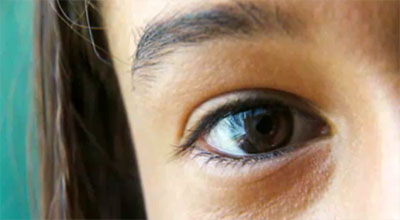
In The New World (2005), Terrence Malick arrests his narrative again and again to note the "mute, inglorious ministers" resting and flitting and fluttering and perching all around the human principals of his story, and what I kept seeing in his aggressively Romantic exoticism was a sense that "the little critters of Nature" (and their surroundings), those buzzing multitudes and sandy reaches and finny prey and leaf-rustling breezes he so diligently observed, comprised the actual New World--not the timber and furs and freedoms and profits--and it is a world Pocahontas (Q'Orianka Kilcher) alone worships, as she does so often at the water's side, invocation and baptism all at once--and without which she dies. I think Malick wishes everyone would leave him and Pocahontas and the Good Earth alone, so they could succumb unimpeded to the mesmerism of ecstasy in the face of all that burgeoning life.
Excuse me if this seems a bit ripe, but right before I watched The New World I saw Ron Fricke's Baraka (1992), a Maya-video that indiscriminately moves from humanity to nature and back again until it's obvious how silly it was in the first place to see the two as separate. Malick as well seems determined to chart the damaging trail we've followed in separating ourselves from nature--and not with any clear eco-ethic, but, as many have noted, an Emersonian Seeing that asks the ego to become an Eye, paradoxically elevating the self by obliterating it.
 And as usual I fell right in. Malick's camera moves from the ships sailing into the bay to the "naturals" emerging from the forest to stare, in a would-be cliched image that takes on a poignancy I cannot resist: They face the sea and the ships, while the continent continues to unfold in unending green at their backs, patient and waiting, but unable to stop them from staring. Mute, indeed: Nature disappears as the settlers move in, their muddy compound in a different world--not a New one, but the old one lifted and tossed down like a dirty rag. Colin Farrell's John Smith, through the ministrations of Pocahontas, sees what the settlers are undoing, and hides until it's too late. Later, Pocahontas goes to England, and Malick shows her in an exhibition hall, dressed as an Englishwoman, bending down to peer at a forlorn mammal in a cage. The image is heavy-handed--one exhibit eyeing another--but it still broke my heart, because she was so beautiful, and because she later finds a pond at her English home and still remembers her ablutions; and the motion of her arms raised, the water cupped and falling, seems more entreaty than praise. Malick turns the business of colonialism into an elegy for Pocahontas--but also Smith, as he stands alone, able only to recall the New World--which, Malick notes sadly, is all he ever could do, since it didn't belong to him, and never would. And his face, I think, reflects that knowledge, doubling the loss, as he mourns a borrowed life and a fleeting glimpse.
And as usual I fell right in. Malick's camera moves from the ships sailing into the bay to the "naturals" emerging from the forest to stare, in a would-be cliched image that takes on a poignancy I cannot resist: They face the sea and the ships, while the continent continues to unfold in unending green at their backs, patient and waiting, but unable to stop them from staring. Mute, indeed: Nature disappears as the settlers move in, their muddy compound in a different world--not a New one, but the old one lifted and tossed down like a dirty rag. Colin Farrell's John Smith, through the ministrations of Pocahontas, sees what the settlers are undoing, and hides until it's too late. Later, Pocahontas goes to England, and Malick shows her in an exhibition hall, dressed as an Englishwoman, bending down to peer at a forlorn mammal in a cage. The image is heavy-handed--one exhibit eyeing another--but it still broke my heart, because she was so beautiful, and because she later finds a pond at her English home and still remembers her ablutions; and the motion of her arms raised, the water cupped and falling, seems more entreaty than praise. Malick turns the business of colonialism into an elegy for Pocahontas--but also Smith, as he stands alone, able only to recall the New World--which, Malick notes sadly, is all he ever could do, since it didn't belong to him, and never would. And his face, I think, reflects that knowledge, doubling the loss, as he mourns a borrowed life and a fleeting glimpse. Malick's deliberate, lingering pace and visual sense--mixing lush exuberance with humble submission--find their best vehicle in The New World, while the sound editing hearkens to every peeper in the marsh, and the music--part Mozart invocation, part Wagner recessional, with "natural" notes of awe and sadness--heightens the bright boundaries of the images as they rise and fall. He seems to be using every language film can manage--visual, aural, narrative--to clarify the scope of the loss of the World in the act of making it New, while calling us to adore the thing lost. The result for me is at the least exhausting; still, it is a film I know I want to see again, despite the weight it asks me to carry. To misquote Elvis Costello, I cannot turn from "all that useful beauty."
Malick's deliberate, lingering pace and visual sense--mixing lush exuberance with humble submission--find their best vehicle in The New World, while the sound editing hearkens to every peeper in the marsh, and the music--part Mozart invocation, part Wagner recessional, with "natural" notes of awe and sadness--heightens the bright boundaries of the images as they rise and fall. He seems to be using every language film can manage--visual, aural, narrative--to clarify the scope of the loss of the World in the act of making it New, while calling us to adore the thing lost. The result for me is at the least exhausting; still, it is a film I know I want to see again, despite the weight it asks me to carry. To misquote Elvis Costello, I cannot turn from "all that useful beauty."
No comments:
Post a Comment